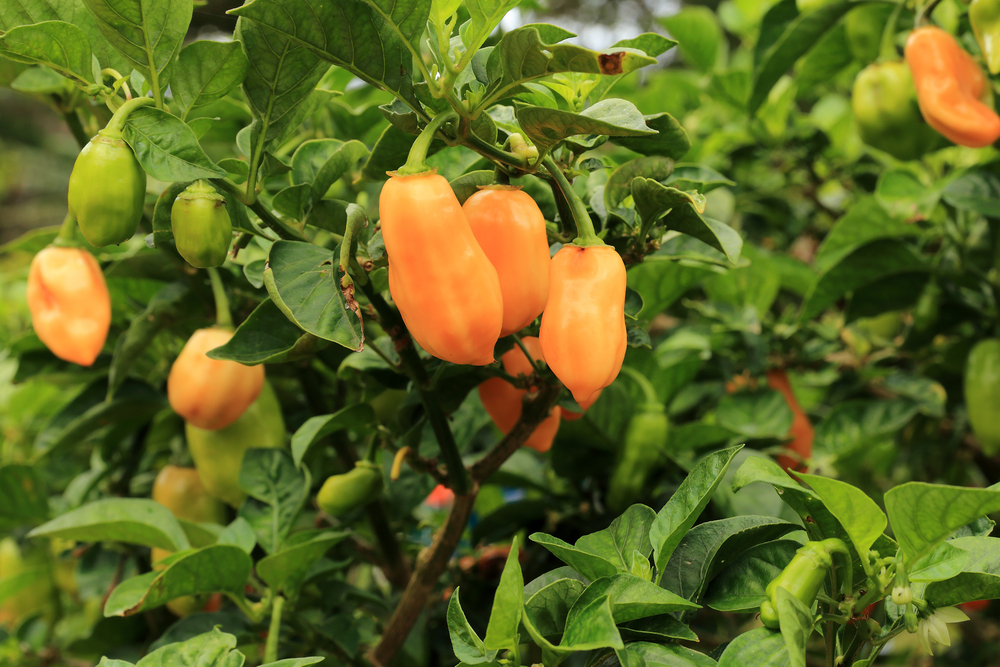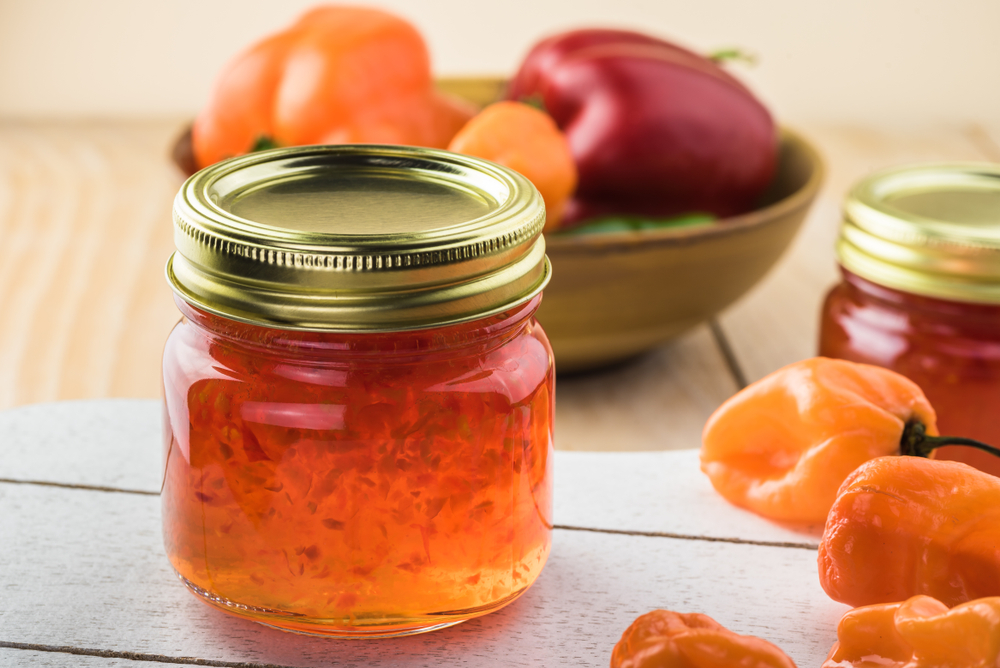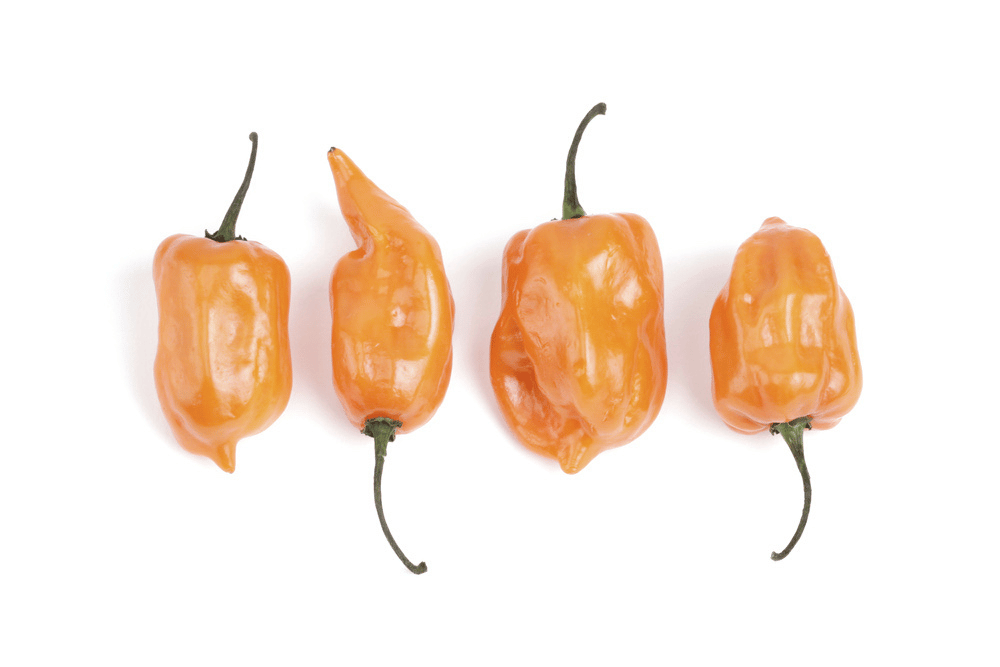Peach Habaneros are a superhot Caribbean chili pepper known for their beautiful peach color and intense heat. Much like your standard orange habanero pepper, these peach beauties are prized for their versatility in the kitchen, especially in tropical fare.
What Is A Peach Habanero Pepper?
Peach habaneros are a beautiful peach-sorbet color pepper that are popular for their incredible heat and fruity, tropical flavor.
The peach habanero peppers are about 2-3 inches long and 1 inch wide. Like other capsicum chinense varieties, peach habaneros have wrinkled skin and are pod-like in shape. As they ripen on the vine, the peppers turn from a bright green color to a pale yellow before finally maturing into a pale peach beauty.
How Hot Is A Peach Habanero?
Habaneros are known for being incredibly spicy peppers, and peach habaneros are no exception! They come in between 150,000-350,000 Scoville Heat Units (SHU) on the Scoville scale, making them slightly hotter on their low end compared to common habaneros, which range between 100,000-350,000 SHUs.
Jalapeno peppers, which average between 2,500-8,000 SHUs, are typically used as a point of comparison when evaluating the spiciness of a particular chili pepper. When compared to jalapenos, peach habaneros are between 18 to 140 hotter, which is a big jump in heat!
Other hot peppers that make great substitutes for peach habaneros include Datil, Madame Jeanette, and scotch bonnet peppers, all of which are right in that 100,000-350,000 SHU ballpark range. If you’re looking for other habanero-type chinense peppers that are milder than peach habaneros, I recommend trying aji dulce peppers (0-1,000 SHUs).

What’s The Difference Between A Peach Habanero & A Regular Habanero Pepper?
The color is the only real difference between peach habaneros and your average standard habanero. Their flavor profiles are incredibly similar, with traditional habaneros being slightly sweeter when compared to peach habaneros. As mentioned, peach habaneros also have a slightly higher floor, but when you’re in the habanero heat range, the difference is negligible.
You can use peach habaneros as a perfect one-to-one replacement for just about any other type of habanero. The benefit of using peach habaneros is mainly in their pretty peach color, which can be used to brighten up salsas, hot sauces, and nearly any other recipe you’d otherwise use orange habaneros for.
Habaneros come in various colors, such as red, orange, and chocolate brown. The red savina and chocolate habanero are the hottest, topping out at 577,000 SHUs.
What Is The Sweetest Habanero?
The name peach habanero suggests that they are sweet in flavor, but this isn’t the case. Peach habaneros have some fruity and sweet notes, but those flavors are nearly overwhelmed by the potency of their heat.
Previously mentioned for being a mild habanero pepper, the aji dulce pepper is the sweetest habanero around! The name aji dulce translates to “sweet chili pepper.” Most aji dulces have nearly no heat at all, comparable to bell peppers, which allows their fruity and floral flavors to take center stage.
How To Use Peach Habanero Peppers
Peach Habaneros are some of the best chili peppers for cooking versatility. Their mild flavors and high heat levels make them a fantastic way to add both spice and a fruity taste to dishes.
Habanero hot sauce is a popular way of using peach habaneros, as you can easily add it to your favorite appetizers and entrees. Peach habanero pepper jelly is delicious on cream cheese and crackers.
One of my personal favorite ways of using peach habaneros is in mango habanero hot sauce. You take the sweetness of ripe mangos and pair it with the intense heat of the peach habaneros. It’s the perfect pairing of sweet and spicy, making it a delectable condiment for your favorite tacos, BBQ, and sandwiches—especially ones with tropical-inspired flavors.

Where To Buy Peach Habaneros
Peach habaneros are rare at most supermarkets, though your local grocery store may have them seasonally. The best place to buy fresh peach habaneros is at farmers’ markets and fresh produce stands during the growing season.
If you can’t get your hands on fresh peach habanero peppers, I recommend growing them yourself! Peach habanero seeds are available through various online sellers, such as Pepper Joe’s. If you want to avoid the process of seed germination, you may also find ready-to-plant habanero plants at your local garden center.
Can You Grow Peach Habanero Peppers?
Growing your own pepper plants is a gratifying process, and thankfully peach habaneros are easy to tend to. The plants themselves grow bushy compared to other pepper plants, so they will need considerable space in your veggie patch.
Like many other Capsicum chinense, peach habaneros need well-draining soil to ensure the plants don’t become overwatered and allow their root systems to grow strong. The use of vegetable fertilizer is recommended to ensure that the peppers grow to full size and are of the highest quality. The last thing you want is for your peach habaneros to look great but taste ‘meh!’
Peach habaneros require full sun exposure throughout the day and need to be watered on average 1-2 times each week. Once planted, they should fully mature in 70-80 days and will yield dozens of peppers during a successful growing season.
Many people plant peppers annually, but you can overwinter your plants if you’d like to have several harvests. Just bring your pepper inside after the first frost of the season and place it in an area of your house near a south-facing window to ensure it gets enough light through the winter.

